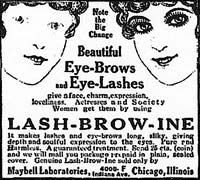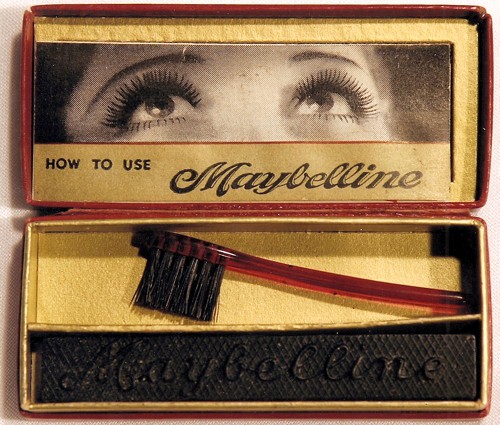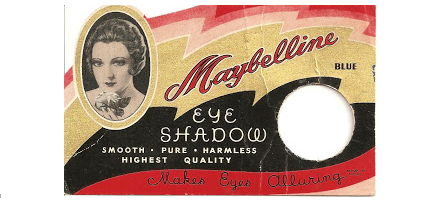Lash-Brow-Ine
Cosmetics and Skin
Anyone who talks about the origins of Maybelline usually starts with Maybelline’s founder, Tom Lyle Williams, watching his sister Mabel applying burnt cork mixed into petroleum jelly to her eyebrows and lashes after she singed them on the stove. The story goes on to describe how Tom Lyle created an eyelash and eyebrow preparation (using a chemistry set) and a business (after borrowing some money from his brother Noel). However, the product he eventually sold through mail-order was developed by Park-Davies not his chemistry set and the business used to sell it was called Maybell Laboratories not Maybelline.
Maybell Laboratories
The product Tom Lyle got from Park-Davis was a scented cream made of white petroleum with oils to provide sheen. He marketed it through his mail-order business as ‘Lash-Brow-Ine’ a name he selected because of its similarity with other eyelash and eyebrow products already on the market such as ‘Eye-Brow-Ine’ and ‘Lashneen’. The business he started to sell Lash-Brow-Ine he named Maybell Laboratories.
Tom Lyle called Lash-Brow-Ine an eyebrow and eyelash growth promoter. Applying Lash-Brow-Ine to eyelashes and eyebrows would have made them appear darker and thicker but would not have stimulated them to grow. However, a long held belief that oils and petrolatum would stimulate hair growth would have given his claim substance in the minds of many potential buyers. Clearly there was demand as sales reached over $100,000 by 1920.
Tom Lyle registered the name ‘Lash-Brow-Ine’ as a trademark in 1917 but by 1921 it was no longer used in advertising. It had been replaced with ‘Maybelline’, a word Tom Lyle reputedly created by combining his sister’s name (Mabel) with the ‘ine’ of Vaseline. The reason usually given for the change was that the original name proved to be a mouthful. However, this simple explanation is not the whole truth.
In 1920 Tom Lyle was taken to court to settle a trademark dispute with Benjamin Ansehl, the founder of ‘Lashbrow Laboratories’. The outcome of the case was that Maybell Laboratories trademark for Lash-Brow-Ine was invalidated and Tom Lyle was given a court order to remove and destroy any references to Lash-Brow-Ine from that day onward.
Lashbrow Laboratories
Lashbrow Laboratories was started by Benjamin Ansehl in St Louis in 1912. It also made an eyebrow and eyelash growth promoter marketed as ‘Lashbrow’. The similarity between the names Lashbrow and Lash-Brow-Ine was the cause of the trademark dispute.
According to court records Lashbrow consisted of petrolatum, beeswax and powdered willow charcoal. It may have been made to a recipe similar to the one given below:
Vaseline yellow 56
Beeswax 4
Lampblack 40
The mixture of ‘vaseline’ and beeswax is melted by being placed in a warm mortar, and the lampblack is well ground in. The preparation is stored in small pots.
Redgrove & Foan, 1930, pp. 67-68
‘Lashbrow’ was marketed as promoting the growth of eyebrows and eyelashes rather than as a mascara. The product sold well enough for Ansehl to extend sales at the end of 1912 to the rest of the United States through Meyer Bros., a wholesale drug company.
Maybelline
In 1917 Tom Lyle developed a new product for darkening and lengthening eyelashes he called ‘Maybelline’. This product was an early version of what would be later known as cake mascara although Williams did not refer to it as such. It was a mixture of sodium stearate soap and pigment mixed together, extruded into strips, stamped and dried and was applied with a small brush that was first wet before being rubbed over the cake.
Why did Williams call the new product ‘Maybelline’? This was a new line and perhaps after all ‘Lash-Brow-Ine’ was hard to say. However, cake mascara is not vaseline based so that part of the story cannot be true.
A name change
Cosmetics and Skin
Anyone who talks about the origins of Maybelline usually starts with Maybelline’s founder, Tom Lyle Williams, watching his sister Mabel applying burnt cork mixed into petroleum jelly to her eyebrows and lashes after she singed them on the stove. The story goes on to describe how Tom Lyle created an eyelash and eyebrow preparation (using a chemistry set) and a business (after borrowing some money from his brother Noel). However, the product he eventually sold through mail-order was developed by Park-Davies not his chemistry set and the business used to sell it was called Maybell Laboratories not Maybelline.
Maybell Laboratories
The product Tom Lyle got from Park-Davis was a scented cream made of white petroleum with oils to provide sheen. He marketed it through his mail-order business as ‘Lash-Brow-Ine’ a name he selected because of its similarity with other eyelash and eyebrow products already on the market such as ‘Eye-Brow-Ine’ and ‘Lashneen’. The business he started to sell Lash-Brow-Ine he named Maybell Laboratories.
Tom Lyle called Lash-Brow-Ine an eyebrow and eyelash growth promoter. Applying Lash-Brow-Ine to eyelashes and eyebrows would have made them appear darker and thicker but would not have stimulated them to grow. However, a long held belief that oils and petrolatum would stimulate hair growth would have given his claim substance in the minds of many potential buyers. Clearly there was demand as sales reached over $100,000 by 1920.
Tom Lyle registered the name ‘Lash-Brow-Ine’ as a trademark in 1917 but by 1921 it was no longer used in advertising. It had been replaced with ‘Maybelline’, a word Tom Lyle reputedly created by combining his sister’s name (Mabel) with the ‘ine’ of Vaseline. The reason usually given for the change was that the original name proved to be a mouthful. However, this simple explanation is not the whole truth.
In 1920 Tom Lyle was taken to court to settle a trademark dispute with Benjamin Ansehl, the founder of ‘Lashbrow Laboratories’. The outcome of the case was that Maybell Laboratories trademark for Lash-Brow-Ine was invalidated and Tom Lyle was given a court order to remove and destroy any references to Lash-Brow-Ine from that day onward.
Lashbrow Laboratories
Lashbrow Laboratories was started by Benjamin Ansehl in St Louis in 1912. It also made an eyebrow and eyelash growth promoter marketed as ‘Lashbrow’. The similarity between the names Lashbrow and Lash-Brow-Ine was the cause of the trademark dispute.
According to court records Lashbrow consisted of petrolatum, beeswax and powdered willow charcoal. It may have been made to a recipe similar to the one given below:
Vaseline yellow 56
Beeswax 4
Lampblack 40
The mixture of ‘vaseline’ and beeswax is melted by being placed in a warm mortar, and the lampblack is well ground in. The preparation is stored in small pots.
Redgrove & Foan, 1930, pp. 67-68
‘Lashbrow’ was marketed as promoting the growth of eyebrows and eyelashes rather than as a mascara. The product sold well enough for Ansehl to extend sales at the end of 1912 to the rest of the United States through Meyer Bros., a wholesale drug company.
Maybelline
In 1917 Tom Lyle developed a new product for darkening and lengthening eyelashes he called ‘Maybelline’. This product was an early version of what would be later known as cake mascara although Williams did not refer to it as such. It was a mixture of sodium stearate soap and pigment mixed together, extruded into strips, stamped and dried and was applied with a small brush that was first wet before being rubbed over the cake.
Why did Williams call the new product ‘Maybelline’? This was a new line and perhaps after all ‘Lash-Brow-Ine’ was hard to say. However, cake mascara is not vaseline based so that part of the story cannot be true.
A name change
Williams advertised extensively, particularly in film magazines such as ‘Photoplay’. In 1920, while the court case was running, advertisements were taken out for Lash-Brow-Ine and Maybelline. In one version the two products are clearly differentiated by suggesting that Lash-Brow-Ine should be applied at night to ‘nourish and promote growth’, while Maybelline makes lashes and eyebrows ‘longer, thicker and more luxuriant’. However, the advertising copy for that year is not consistent and in another advertisement the two products appear to be equivalent:
Just a wee touch of the little brush over your eyelashes and eyebrows with Lash-Brow-Ine and you will find a new beauty in your eyes. For Maybelline instantly furnishes that delicate touch of darker color so necessary to eyelashes and eyebrows while they are gently invigorated by the little brush.
1920 Maybell Laboratories Advertisement - 1920 [September] Viola Dana endorsement for ‘Lash- Brow-Ine’ and ‘Maybelline’.
The lack of consistency in the advertising in 1920 probably reflects the uncertainty generated by the court case. However, it is clear that Lash-Brow-Ine was not renamed Maybelline simply because it was hard to say. Tom Lyle was probably hoping to maintain both products on the market as Lash-Brow-Ine had been a good earner and 1920 was not the best time to lose it. The world was in the middle of a post-war depression that would run through to 1922 so times were tough and as Maybelline was more expensive – it sold for 75 cents compared to 50 cents for Lash-Brow-Ine – there may have been concerns about potential sales. However, the court case forced Tom Lyle’s hand and Lash-Brow-Ine soon disappeared.
In 1923, Maybell Laboratories was renamed Maybelline and concentrated operations on eye make-up. The business flourished, helped by the continued use of extensive advertising and Tom Lyle’s shrewd use of actresses as role models. A liquid form of Maybelline was made available and sales of the “solid form” and “waterproof liquid form” of Maybelline did well, eventually finding their way onto the toilet counters of drug, variety and department stores.
See also Maybelline
19th April 2010
Sources
Poucher, W. A. (1932) Perfumes, cosmetics and soaps, Vols. 1-2 (4th ed.). London: Chapman and Hall.
Quirk, J. R. (1920) Photoplay magazine. Chicago, Ill.: Photoplay Publishing Co.
Redgrove, H. S. & Foan, G. A. (1930). Paint, powder and patches: A handbook of make-up for stage and carnival. London: William Heinemann.
The United States Trade-Mark Association. (1921). The trade-mark reporter. Volume 10. New York: Author.
Williams, S. & Youngs, B. (2010). The Maybelline story and the spirited family dynasty behind it. Florida: Bettie Youngs Books Publishing.
1920 [April-May] Ethyl Clayton endorsement for ‘Lash-Brow-Ine’.1920 [December] Ethyl Clayton endorsement Lash-Brow-Ine and other cosmetics. Note the Maybelline box in the background and the interchange of Lash-Brow-Ine and Maybelline in the copy.
Copyright © 2011 James Bennett
email: cosmeticsandskin@gmail.com
Vogues in beauty come and go then crop up again in the never-ceasing search for something new.
—G. Vail (1947)
email: cosmeticsandskin@gmail.com
1920 Maybell Laboratories Advertisement - 1920 [September] Viola Dana endorsement for ‘Lash- Brow-Ine’ and ‘Maybelline’.
The lack of consistency in the advertising in 1920 probably reflects the uncertainty generated by the court case. However, it is clear that Lash-Brow-Ine was not renamed Maybelline simply because it was hard to say. Tom Lyle was probably hoping to maintain both products on the market as Lash-Brow-Ine had been a good earner and 1920 was not the best time to lose it. The world was in the middle of a post-war depression that would run through to 1922 so times were tough and as Maybelline was more expensive – it sold for 75 cents compared to 50 cents for Lash-Brow-Ine – there may have been concerns about potential sales. However, the court case forced Tom Lyle’s hand and Lash-Brow-Ine soon disappeared.
In 1923, Maybell Laboratories was renamed Maybelline and concentrated operations on eye make-up. The business flourished, helped by the continued use of extensive advertising and Tom Lyle’s shrewd use of actresses as role models. A liquid form of Maybelline was made available and sales of the “solid form” and “waterproof liquid form” of Maybelline did well, eventually finding their way onto the toilet counters of drug, variety and department stores.
See also Maybelline
19th April 2010
Sources
Poucher, W. A. (1932) Perfumes, cosmetics and soaps, Vols. 1-2 (4th ed.). London: Chapman and Hall.
Quirk, J. R. (1920) Photoplay magazine. Chicago, Ill.: Photoplay Publishing Co.
Redgrove, H. S. & Foan, G. A. (1930). Paint, powder and patches: A handbook of make-up for stage and carnival. London: William Heinemann.
The United States Trade-Mark Association. (1921). The trade-mark reporter. Volume 10. New York: Author.
Williams, S. & Youngs, B. (2010). The Maybelline story and the spirited family dynasty behind it. Florida: Bettie Youngs Books Publishing.
1920 [April-May] Ethyl Clayton endorsement for ‘Lash-Brow-Ine’.1920 [December] Ethyl Clayton endorsement Lash-Brow-Ine and other cosmetics. Note the Maybelline box in the background and the interchange of Lash-Brow-Ine and Maybelline in the copy.
Copyright © 2011 James Bennett
email: cosmeticsandskin@gmail.com
Vogues in beauty come and go then crop up again in the never-ceasing search for something new.
—G. Vail (1947)
email: cosmeticsandskin@gmail.com

















